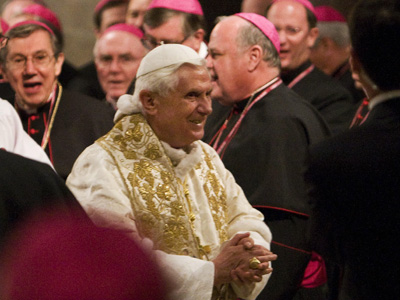
Pope Benedict XVI is celebrating mass in Washington today and a nation that walks a fine line between Saturday night and Sunday morning, as the Rev. Jimmy Buffet once said, is struggling when it comes to discussions about the visit.
Last night, for example, the pontiff told bishops, the Boston Globe said, “to do better communicating with the public, connecting with priests, and educating children; he also exhorted them to demonstrate unfettered support for immigrants. And he offered an analysis of the role of religion in America, suggesting that the freedom here has at the same time allowed faith to flourish but also can ‘subtly reduce religious belief to a lowest common denominator.'”
OK, let’s talk about that.
“The pontiff doesn’t like to drink wine with dinner, and at dinner last night he was seen with a can of orange Fanta, and some Cracker Jack was also seen,” the commentator on CNN noted during live coverage of the mass this morning. That was a few minutes after noted theologian Mike Piazza, who conducted services for years behind the plate at Shea Stadium, described the differences between Pope Benedict and his predecessors.
So what are viewers left with? Here’s a review of the coverage so far from Alessandra Stanley of the New York Times:
Cable news channels and the networks interrupted their regular programming to provide live coverage of the pope at the White House as he read his speech precisely and evenly in a slight German accent. He graciously shook hands with cabinet members and elected officials (Nancy Pelosi, the House speaker, kissed his ring). The pope, who turned 81 on Wednesday, smiled winningly when the crowd broke out in a ragged version of “Happy Birthday.” He looked pleased — he smiled and stretched out his arms to well-wishers — when the soprano Kathleen Battle led a more expert rendition of the song. But it provided, at best, a fleeting look at the pope. TV commentators tried to compensate, extolling the excitement of the crowds and the geniality of the guest of honor. One anchor declared that the pope looked “thoroughly overjoyed.”
The challenge in covering a papal visit, then, is fairly enormous: don’t make it an infomercial for the Vatican, explore the issues — good and bad — that have challenged the church and its followers, and don’t come off looking anti-Catholic.
Consider this letter today in the Star Tribune:
The Star Tribune covers it by running an Associated Press article with 35 column inches of written copy (plus some pictures). The first 28 of those 35 inches deal with sexual abuse by Catholic clergy over the past half-century. Only the last 7 inches refer to other aspects of the pope’s visit.
Some Americans feel the media are anti-Catholic. Where in the world might they ever get such an idea?
Peter Steinfels, a religion columnist for the Times and professor at Fordham University provided one of the more insightful comments on the visit last night on… of all places … The Daily Show (Video here):
“I think he’ll probably deliver messages that are complicated and deserve analysis and parsing, but he’ll leave the country and we’ll never pay any attention again to those complicated messages,” he said
So maybe the visit is about us. Steinfels says we only discuss religion when it intersects with the culture wars. “We have a hard time dealing with genuine, religious, profound messages, and I think that this pope really does think that religion is not a set of propositions that you believe in some fundamental orientation toward the universe which he thinks is love, and we’ve got to find a political thing on page 82 when he writes an encyclical.”
If you’d like to discuss the papal visit, be sure to listen to Midday today at 11.
(Photo: Mandal Ngan, AFP/Getty Images)
